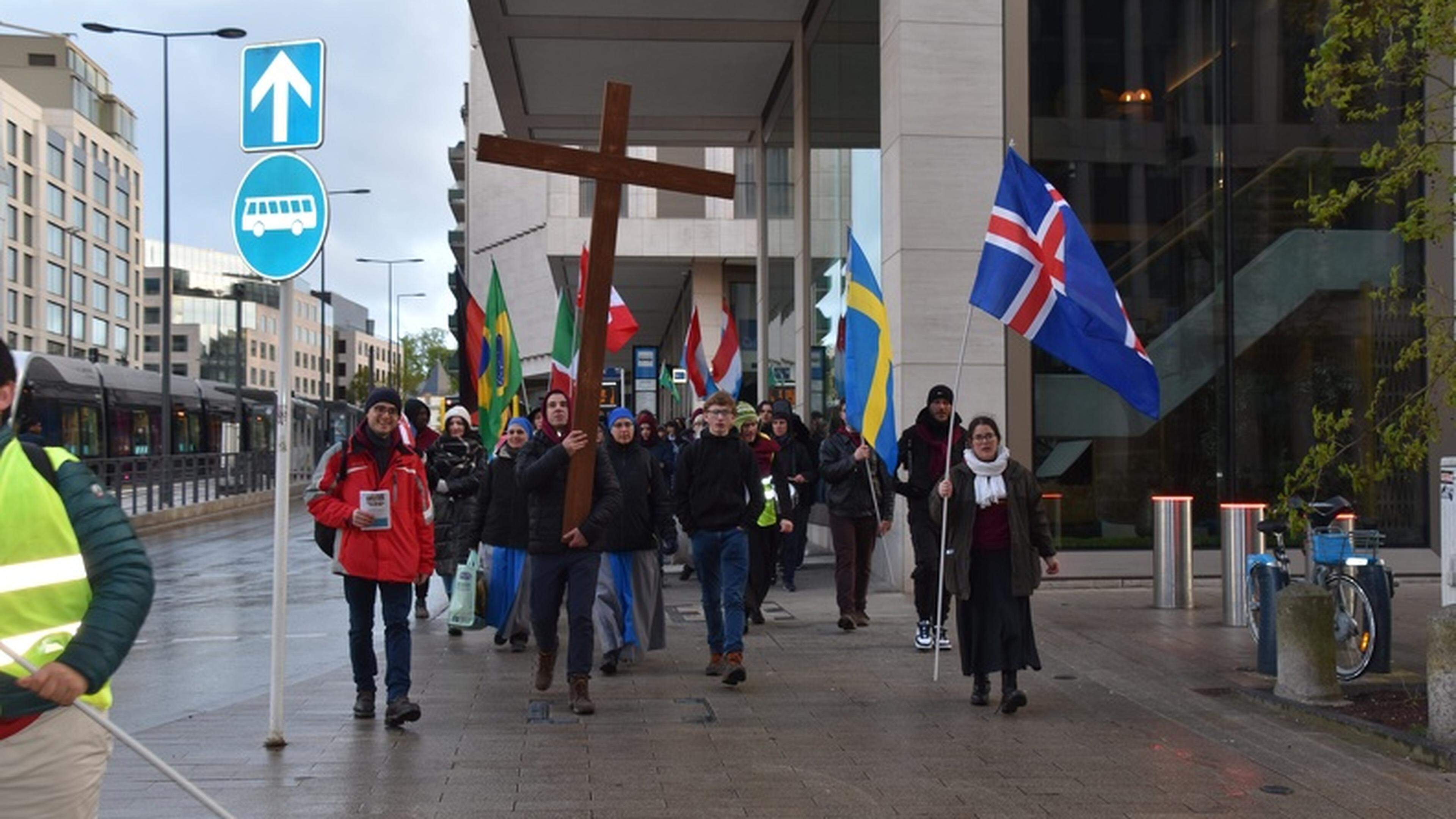400 years of Our Lady Oktave: pilgrimage and faith tradition in Luxembourg

It has been 400 years since setting up the statue of the « Trösterin of the Trifeworthy » on the Glacisfeld in the city of Luxembourg (December 8, 1624) This pilgrimage was progressively created: our « octave », up to date the heart of native Catholicism. This Our Lady-Oktave as a pilgrimage period knew height and lows in the course of its long existence. To date, she calls every year, after Easter, thousands of pilgrims from Luxembourg and the border regions, even from America in this anniversary year, into the Mariendom of our capital.
Profane and church history context
The Catholic Reform of the Council of Trento (1545-1563) had a pronounced veneration of the picture of the Catholic Reform of the Council of Trento in the 17th century to internalize and spiritual faith practice. Pilgrims became a denominational distinction feature. The pilgrimage to the Consolatrix Afflictorum, which was created on the Glacis, also laid the basis for a Luxembourg patriotism, which, particularly from the second half of the 19th century, and continued to this day.
A pilgrim procession, accompanied by Cardinal Jean-Claude Hollerich and Auxiliary Bishop Leo Wagener, on the way to the cathedral. Photo: Georges Hellinghausen
The fact that the Jesuits were committed to pilgrimage – they remained organizer of the octave until the dissolution of their order in 1773 – explains not least from the fact that their founder, St. Ignatius of Loyola, described himself as « pilgrims » with regard to his spiritual path and his whole life.
From the beginning, the octavic pilgrimage was bound to the picture reinforced by the Trento Council, closer to the cult of the Baldemother, depicted by the image of grace.
Need pilgrimages and long -distance pilgrimages
Initially related to the city of Luxembourg, the local pilgrimage on the Glacis developed into an important aspect of popular piety for city, country and region after 1640. Pilgrims – occasionally or in groups – gradually came from the Duchy of Luxembourg, but also from the neighboring Trier Land, the Saar area, the Northern Eifel and the Cologne area as well as from Lorraine.
How Luxembourg and the octave shaped each other
However, the octavic pilgrimage is to be born into the series of local pilgrimages, which developed in the baroque period. It was often daily pilgrimages to Marienheiligünde in an achievable geographical area; They set themselves away from the medieval long -distance pilgrimages, such as Rome, Jerusalem or Santiago de Compostela.
Arrived: pilgrims in front of the grace image on the « votive « atar. Octave 2024. Photo: Georges Hellinghausen
The pilgrimage destination The consolatrix admirers was initially the grace chapel on the Glacis, which had recorded the statue from 1628. There the first « octaves », ie religious weeks of Mary were held with devotion forms such as devotions, trade fairs and processions. However, the transmission of the statue of the « Trösterin of the Torn » was soon typical of the official octave week during the Ancien regime, i.e. before 1800.
In the Jesuit Church, larger pilgrimage masses were recorded than in the very small chapel, although this had already been increased by twice in 1640-42. Pilgrims, especially when it was processed, happened during this time with a popular, baroque splendor – from today’s perspective felt as a religious « triumphalism ». Since the early 19th century and the destruction of the chapel on the Glacis, the Liebfrauenkirche, the former college church of the Jesuits and since 1870 cathedral, has been the only goal of the octave pilgrimage.
Markstones and motivations
Spontaneously created and initially left loosely to the individual groups and parishes, the octave pilgrimage after the two consecration from 1666 and 1678 (Maria chosen as city or state patron) received a structured form through the church hierarchy. The two responsible bishops of Trier and Liège put the eight-day celebration of the festival of the Consolatrix Aflictorum, which revived the dual election every year, initially in October, from 1679, in the period after Easter, when it takes place to this day. In order to take into account the pilgrimage current, which increased from 1840, the pilgrimage period was expanded twice: in 1898 by half a week, in 1921 another half a week. This includes two weeks, even though the name « Our Lady Oktave » has remained popularly as in the official church-social nomenclature.
Historical Ignatius tapiserie in the cathedral. Photo: Georges Hellinghausen
The pilgrimage path could be short or long. To date, rosary is prayed or sung on the way. From the 19th century, the post -carriage and the railroad ride had also been used for the pilgrimage from 1860. Officially, the procession then set up at a distance of the pilgrimage church, often at the « old bridge » (Viaduc), in order to then be accompanied by the clergy and communion children and led by the local music society. Sometimes it happens today.
New documents sharpen the view of 400 years of the pilgrimage of Marien
What was and is the motivation of the pilgrims? It changed according to the time constellations. The Luxembourg pollute is to be awarded a whole series of such petitions, in which the war-needed war, especially the thirty-year war, famous people and pest outbursts were looking for unearthly help in their suffering.
Pilgrims, although there was a lot of up and down in this practice, have always been part of Catholic life. Pilgrimage passages were made to obtain grace, such as healings or special prayer hearings, to facilitate conscience, to gain the estate of sins or general salvation. They also made a pilgrimage as a thank you for received benefits. Many of them are still preserved and decorate the image of grace and the « votive altar » (pilgrimage altar). However, the pilgrimage in the Ancien Regime, i.e. before 1800, could also be a fine criminal criminal, even a murderer, in the sense of a prison system that had been determined by the court ruling. The indulgence for the purpose of the “time penalties”, which should ensure eternal salvation, played an important role from the start to the beginning of the 20th century.
Pilgrims today
Around 1900 the pilgrimage in Luxembourg experienced another climax and crossed the 100,000 border. After the Second World War there was a certain decrease. But the pilgrimage on the threshold in the 21st century was booming again as a form of an expression of religious life in general. In modern and postmodernity, pilgrims have become an outward -external act of faith that deliberately manifests itself in a secularized world. Existantly, the pilgrimage is understood as praying with your feet and illustrates the theological understanding of faith as a way. As a church highlight (« Temps Fort »), the octave pilgrimage as part of a current « event culture » also receives new topicality.
This also applies to pilgrimages that have arisen abroad from the worship of the Luxembourg « Trösterin »: in Kevelaer (since 1642), in Carey/Ohio (USA) since 1875. From America, 80 pilgrims of Luxembourg descent, with a new flag, are expected for the final procession.
Each pilgrim has their own octa blows. However, there is currently a trend to reduce the octave pilgrimage to participation in a service in the cathedral, to which one commands – if possible. Road traffic and stress make the pilgrimage, as is customary for centuries, i.e. on foot, it is often impossible. However, the path is at least as important as the goal in terms of pilgrims.








